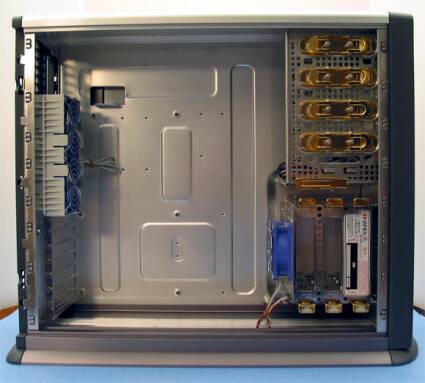2003 Winter Case Review Part 2: The ATX Avalanche
Superpower Superb Series KC2301B, Continued
The KC2301B from Superpower has the honor of being the heaviest and most well-built case we have reviewed. Checking in at nearly 32 pounds, the KC2301B is built like a tank. It doesn't weigh as much as tank, but you will have a difficult time convincing someone who is trying to transport this case otherwise. Conceptually, the idea behind the KC2301B is quite unique. In industrial environments, this case will excel. As it is built from thick aluminum (and we do mean thick!) the KC2301B case is slotted and vented to behave much like one huge heat sink. The problem with this concept, however, is that since there are no actual connections to the case itself for heat dissipation transfer there is no real method to verify this theory. Certainly, Superpower's idea is in the right place. Their design is both eye catching and quite elegant, but most users will never be able to take this case out of their homes to show it off at LAN parties, because it is just too heavy to transport easily.
A look at the inside of the KC2301B.
The internal construction of the KC2301B is elegant. Featuring gold-style, snap fasteners for screwless mounting of devices this case adds a real flair to its design. The case exhibits absolutely (and we do mean absolutely) no bend or twist: but, how could there be? With metals that in some areas reach ¼" thick, there cannot be any bend or twist. The internal construction features a variety of rolled and folded edges. We found some of the ends of the rolled or folded corners to be a little sharp, particularly the rolled edges around the 5.25" drive bay. Overall, the internal construction of the KC2301B is very, very good.
The internal cooling setup of the KC2301B utilizes a baseline three-fan system: two fans in the rear of the case and a single fan mounted in the front of the hard drive cage to push circulate the air forward for exhausting heat out the two rear fans. The outer shell of the KC2301B is designed with ridges in almost a heat sink, fin-like configuration to give the case an illusion of being one giant heat sink. In practice, however, we saw very little to indicate an advantage to this type of strategy. While the KC2301B did pass our cooling and performance tests with no problem, we cannot really complain about its cooling performance. However, the illusion that the cooling is enhanced by the outer shell design is somewhat misleading.
Get Tom's Hardware's best news and in-depth reviews, straight to your inbox.
Current page: Superpower Superb Series KC2301B, Continued
Prev Page Superpower Superb Series KC2301B Next Page Superpower Superb Series KC2301B, Continued